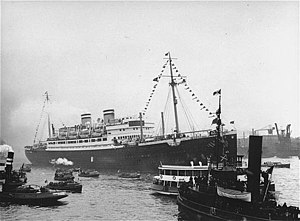
Back موتورشيف سانت لويس Arabic Сент Луис (кораб) Bulgarian MS St. Louis Catalan St. Louis (Schiff, 1929) German Σεντ Λούις (πλοίο) Greek Saint Louis (ŝipo) Esperanto Saint Louis (1929) Spanish MS St. Louis Basque کشتی اماس سنت لوئیس Persian MS St. Louis Finnish

| |
| History | |
|---|---|
| Name | St. Louis |
| Owner | Hamburg-America Line |
| Port of registry | |
| Builder | Bremer-Vulkan Shipyards in Bremen, Germany |
| Laid down | June 16, 1925 |
| Launched | August 2, 1928 |
| Maiden voyage | March 28, 1929 |
| Fate | Scrapped in 1952 |
| General characteristics | |
| Type | Passenger Liner |
| Tonnage | 16,732 gross register tons (GRT) |
| Length | 574 ft (175 m) |
| Beam | 72 ft (22 m) |
| Propulsion | MAN diesels, twin triple-blade propellers |
| Speed | 16 knots (30 km/h; 18 mph) |
| Capacity | 973 passengers (270 cabin, 287 tourist, 416 third) |
MS St. Louis was a diesel-powered passenger ship properly referred to with the prefix MS or MV, built by the Bremer Vulkan shipyards in Bremen for HAPAG, better known in English as the Hamburg America Line. The ship was named after the city of St. Louis, Missouri. Her sister ship, MS Milwaukee, was also a diesel powered motor vessel owned by the Hamburg America Line. St. Louis regularly sailed the trans-Atlantic route from Hamburg to Halifax, Nova Scotia, and New York City, and made cruises to the Canary Islands, Madeira, Spain; and Morocco. St. Louis was built for both transatlantic liner service and for leisure cruises.[2]
During the build-up to World War II, the St. Louis carried more than 900 Jewish refugees from Nazi Germany in 1939 intending to escape anti-Semitic persecution. The refugees first tried to disembark in Cuba but were denied permission to land. After Cuba, the captain, Gustav Schröder, went to the United States and Canada, trying to find a nation to take the Jews in, but both nations refused. He finally returned the ship to Europe, where various countries, including the United Kingdom, Belgium, the Netherlands and France, accepted some refugees. Many were later caught in Nazi roundups of Jews in the occupied countries of Belgium, France and the Netherlands, and some historians have estimated that approximately a quarter of them were killed in death camps during World War II.[3] These events, also known as the "Voyage of the Damned", have inspired film, opera, and fiction.
- ^ "Photo Archives United States Holocaust Memorial Museum". Archived from the original on June 29, 2016. Retrieved April 24, 2014.
- ^ "MS St. Louis German ocean liner". Encyclopædia Britannica.
- ^ Madokoro, Laura (August 9, 2021). "Remembering the Voyage of the St. Louis". Active History.
© MMXXIII Rich X Search. We shall prevail. All rights reserved. Rich X Search